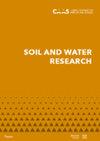砂质土壤中土壤水分电容探头的室内标定
IF 1.7
4区 农林科学
Q4 SOIL SCIENCE
引用次数: 8
摘要
确定和减轻滑坡风险是一项技术-科学目标,特别是对于保护和适当的领土管理和规划而言。边坡的稳定性取决于孔隙压力的分布,而孔隙压力的分布受饱和锋通过非饱和区传播的影响,其监测有助于了解任何可能的不稳定性。这种监测可由基于相对介电常数测量的传感器进行。测量结果与土壤湿度之间的可靠关系是必要的。本研究的主要目的是评估特定电容传感器(Drill & Drop, Sentek sensor Technologies)的实验室校准方案。选择了两种单粒砂进行校准。在三个相对密度值(DR = 40%、60%和80%)下对七个体积含水量值(θv范围为0.00%至36.26%)进行实验室测试。在实验测量的基础上,确定了给定相对密度值下的土壤特性校准曲线;特别地,采用一个简单的幂律来描述探头读数作为体积含水量的函数。结果表明,相对密度值对试验结果影响较小,因此可以通过简单的回归分析来拟合每种砂土的全部室内试验结果,从而得到土壤特性校准曲线。计算的决定系数(R2 = 0.96÷0.99)和均方根误差(RMSE = 1.4%÷2.8%)值证实了拟合优度。以θv和平均粒度D50为自变量,进行多元线性回归,以得到适用于两种砂岩的更通用的拟合曲线;R2和RMSE分别为0.97和2.41%,证实了校准曲线的适用性。最后,将实验室校准曲线与制造商提供的曲线进行比较,从而增加了土壤特定校准的必要性。本文章由计算机程序翻译,如有差异,请以英文原文为准。
The laboratory calibration of a soil moisture capacitance probe in sandy soils
Determining and mitigating landslide risk is a technical-scientific objective, particularly for the protection and proper territorial management and planning. The slope stability depends on the pore pressure distribution, which is influenced by the saturation front propagation through the unsaturated zone, whose monitoring is useful to understand any possible instabilities. Such monitoring may be undertaken by sensors based on the measurement of the relative dielectric permittivity. Reliable relationships between the measurement and the soil moisture are necessary. The main objective of this study is to assess a laboratory calibration protocol for a specific capacitance sensor (Drill & Drop, Sentek Sensor Technologies). Two monogranular sands have been selected for the calibration purpose. The laboratory tests were performed under three relative density values (DR equal to 40%, 60% and 80%) for seven volumetric water content values (θv ranging from 0.00% to 36.26%). Based on the experimental measurements, the soil-specific calibration curves were determined at an assigned relative density value; in particular, a simple power law is adopted to describe the probe’s reading as a function of the volumetric water content. The results point out that the relative density values slightly affect the tests, thus, the soil-specific calibration curves are derived based on a simple regression analysis fitting the whole set of the laboratory tests validated for each sand. The calculated coefficient of determination (R2 = 0.96÷0.99) and root mean square error (RMSE = 1.4%÷2.8%) values confirm the goodness of fit. In order to propose more general fitting curves, suitable for both the investigated sands, multiple linear regressions are performed by considering θv and the mean grain size, D50 as independent variables; again, the R2 and RMSE values equal to 0.97 and 2.41%, respectively, confirm the suitability of the calibration curve. Finally, the laboratory calibration curves are compared with the manufacturer-supplied curves, thus, enhancing the need for the soil-specific calibration.
求助全文
通过发布文献求助,成功后即可免费获取论文全文。
去求助
来源期刊

Soil and Water Research
Water resources, Soil Science, Agriculture-WATER RESOURCES
CiteScore
4.60
自引率
0.00%
发文量
26
审稿时长
>12 weeks
期刊介绍:
An international peer-reviewed journal published under the auspices of the Czech Academy of Agricultural Sciences and financed by the Ministry of Agriculture of the Czech Republic. Published since 2006.
Thematic: original papers, short communications and critical reviews from all fields of science and engineering related to soil and water and their interactions in natural and man-modified landscapes, with a particular focus on agricultural land use. The fields encompassed include, but are not limited to, the basic and applied soil science, soil hydrology, irrigation and drainage of lands, hydrology, management and revitalisation of small water streams and small water reservoirs, including fishponds, soil erosion research and control, drought and flood control, wetland restoration and protection, surface and ground water protection in therms of their quantity and quality.
 求助内容:
求助内容: 应助结果提醒方式:
应助结果提醒方式:


